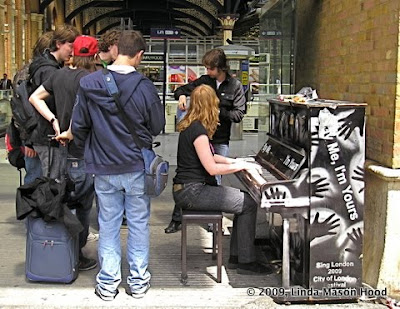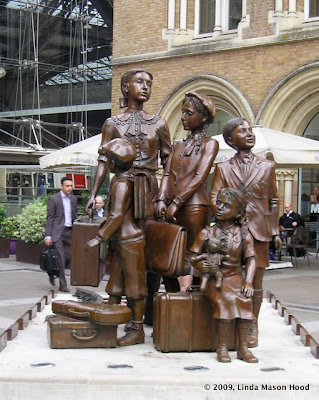Misery is surely a fitting description for my experience with Apple's Migration Assistant utility. Hoping to save someone else from a similar ordeal, I'm going to share my experience.
I recently replaced my son's 4-year-old
Powerbook G4 1.5 with the new
MacBook Pro Core 2 Duo 2.26. In many respects this new MacBook was an exciting improvement over the poor Powerbook, with its missing tab key and dented case.
 Powerbook on the left; MacBook Pro on the right.
Powerbook on the left; MacBook Pro on the right.
The
Migration Assistant utility seemed to be the best way to move my son's 54 gigabytes of data. This utility would transfer not only the user account but also all the data and settings associated with it. In the end, Migration Assistant did finally deliver as promised, but not without inflicting significant pain.
The
FIRST attempt at migration failed because I selected
Wireless Network as the migration method. It seemed the easiest, but after 30 minutes of "preparing to migrate..." Migration Assistant finally estimated that the migration would take about
15 hours. Who has that much patience, right? So I canceled that migration attempt.
The
SECOND attempt started badly because it seemed to think data for the user had already been transferred from the previous aborted attempt. Therefore, I set up another user account, very similar to the first one. Having now located my ethernet cable, I selected
Ethernet as the migration method. That reduced the estimated time to
3 hours. Much better!
Near the end of the process the screen display said "
less than one minute remaining" -- for 20 minutes or so. With mounting concern, I turned to the internet for help and read that one should not assume Migration Assistant was in trouble unless it ran for more that 12 hours. By this time it was midnight, so I just went to bed and left it to run its course.
By 7 AM the screen displayed a message "...
finished successfully." However, clicking on the Finish button produced a message that there were errors -- errors which would remain a mystery because there was no explanation or error log. Left completely to my own devices, I started poking around in the Finder to see what Migration Assistant had done, or not done, and I found indications that all was not well.
Clearly in need of help, I called Apple Support. After 15 minutes of troubleshooting I was transferred to a technical specialist named Sean. Patiently, he explained that establishing multiple user accounts with similar names had caused unnecessary copying of data. His bigger concern was that system security programs might encounter future hard-to-diagnose issues stemming from those user accounts with extremely similar names. (User accounts form the very basis for all system security.) He advised me to erase the hard drive --
Gulp! -- and restore the system to the way it was when I took it out of the box.
Entering a new realm of Mac maintenance, then, I erased the hard drive with one click, and reinstalled the operating system with those disks that come with every new computer. You know, the ones you hope you never have to use... But wow! What an improvement over Microsoft! There were no confusing questions to answer, and the whole operation took only 30 minutes.
Off and running now, I began my
THIRD attempt at Migration Assistant. Again I selected
Ethernet as the migration method. After an hour of "Searching for documents to migrate to the new computer..." I called Apple Support again. Sean was not available, but Jay explained why this third attempt would never complete (I'll spare you that convoluted story) and advised the FireWire migration method.
Since I needed to go out and buy a FireWire cable, Jay
called back in an hour -- yes, a support person actually
called me back!!! -- and thus began my
FOURTH attempt at Migration Assistant. I was a little nervous about going into
FireWire target disk mode, a process used by the
FireWire method. However, working with FireWire target disk mode proved to be far less scary than booting up a Windows PC in SAFE mode. You just hold down the T key while you boot up, and release it when the FireWire symbol appears on the screen. At that point the whole computer is just an external hard drive. But returning to the saga, the estimated migration time using the FireWire method dropped to
1 hour 30 minutes! Jay said he'd call back a second time to make sure it finished successfully. At this point I actually began to believe I might complete this process in my lifetime!
Migration Assistant completed about 15 minutes early so I had a chance to verify the results. All the data was transferred and the user account was properly named. The machine name that was transferred included the word
Powerbook, and so I replaced that with the words
MacBook Pro. The dock contained some question marks representing applications I had chosen not to transfer, so I got rid of those empty dock items. I installed the iLife applications which were erased when I did the operating system re-install. I also installed the 2008 version of Microsoft Office for Mac. My son would need to download fresh copies of a few internet applications, but other than that, everything looked good. When Jay called, he concurred that this fourth attempt had succeeded.
Finally -- 21 hours after beginning the first migration attempt -- I able to hand over the MacBook Pro to my son.
Lessons Learned: If you're using Migration Assistant to transfer data from an older Mac to a new one,
1) GIVE A FICTITIOUS NAME WHEN YOU BOOT UP THE COMPUTER FOR THE FIRST TIME. (Actually, this tip comes word-for-word from Jay in the Apple Tech Support group.) Doing this will establish a user account on your new system that is completely different from your old system. Migration Assistant will then have no conflicts whatsoever and can copy your old user account and everything associated with it. When Migration Assistant has completed, just delete the fictitious user account.
2) USE A FIREWIRE CABLE. (This tip comes from my own experience.) Forget about doing it any other way. Anyone who can afford an Apple computer can afford a $20 FireWire cable. Caution: You will need to know the speed of the FireWire port on each machine. You can look that up online, or just call Apple Support. Based on the model number I gave him, Jay informed me that the Powerbook had a 400 Mbps (megabytes per second) FireWire port, whereas the MacBook Pro had an 800 Mbps port. He instructed me to by a "400 to 800" FireWire cable.
Alternatives: (if you have no"
geeky" inclinations whatsoever)
a) Make an appointment at the Genius Bar in an Apple Store, and an Apple Genius (in-store tech support person) will do the whole migration for you. You will have to take your old Mac and your new Mac into the store and maybe leave them both there for a day or so. But hey, if your at-home migration goes as badly as mine, you wouldn't have had the use of your computer anyway! This service is free, so if you live near an Apple Store, why not leave data migration to the experts?
b) Call Apple Support before you turn on the new machine for the first time. If I were you, I'd ask the agent who picks up the call to transfer you to Technical Support for help transferring data from one computer to another. Go right to second level support, as these guys know a little more and explain things a little better. Even if you didn't buy the Apple Care extended warranty, this call is covered under your purchase warranty.
Do I wish I had moved the data manually from a backup? No. When it works properly, Migration Assistant is amazing. My son felt instantly "at home" on the new MacBook Pro. There were no preferences to adjust; everything looked and felt the same. I just don't think all the aggravation I went through was necessary. Apple usually does a pretty decent job of making applications user friendly, so I never expected to encounter such poor instructions. If Apple feels compelled to offer Wireless and Ethernet as migration options, they owe it to the user to explain the implications of each choice. That alone would have spared me 21 hours of anxiety and uncertainty. So yea, it was a real pain and I regret that. In the end, though, I learned a few things to share here with anyone -- even the folks at Apple -- who might stumble upon this post. Please feel free to leave a comment if you found this helpful.
© 2009, Linda Mason Hood
Truffles, Turtles & Tunes Copyright Statement
 This Christmas season has been full of Irish music activities. For me, the Christmas season began in early December when I attended a Cherish The Ladies concert, a rousing, energetic performance of many of the songs and tunes on their new Christmas CD, A Star in the East. As a member of the Washington Square Harp and Shamrock Orchestra I was part of Mick Moloney's Irish Christmas concert series at the Irish Arts Center. The WSHSO also played in the Airneal na Nollag, an annual holiday celebration at New York University's Glucksman Ireland House. Additionally, we provided music for the Christmas party of the Irish American Bar Association of New York. I attended a session at the Landmark Tavern when Jimmy Crowley was in town. I've been to several sessions at Lillie's this month, and last night I went to the massive Christmas session at Dempsey's. All the bars are beautifully decorated for Christmas, making the sessions seem very festive.
This Christmas season has been full of Irish music activities. For me, the Christmas season began in early December when I attended a Cherish The Ladies concert, a rousing, energetic performance of many of the songs and tunes on their new Christmas CD, A Star in the East. As a member of the Washington Square Harp and Shamrock Orchestra I was part of Mick Moloney's Irish Christmas concert series at the Irish Arts Center. The WSHSO also played in the Airneal na Nollag, an annual holiday celebration at New York University's Glucksman Ireland House. Additionally, we provided music for the Christmas party of the Irish American Bar Association of New York. I attended a session at the Landmark Tavern when Jimmy Crowley was in town. I've been to several sessions at Lillie's this month, and last night I went to the massive Christmas session at Dempsey's. All the bars are beautifully decorated for Christmas, making the sessions seem very festive.































